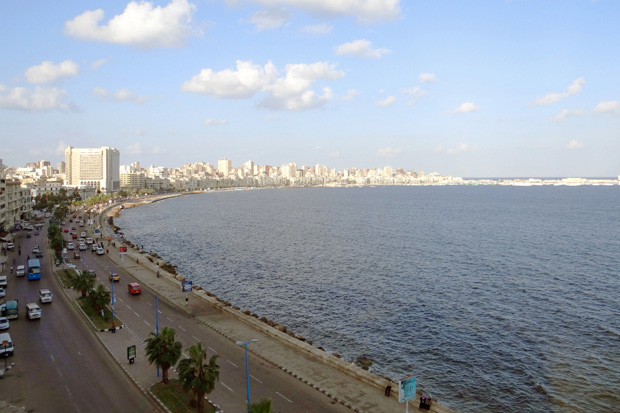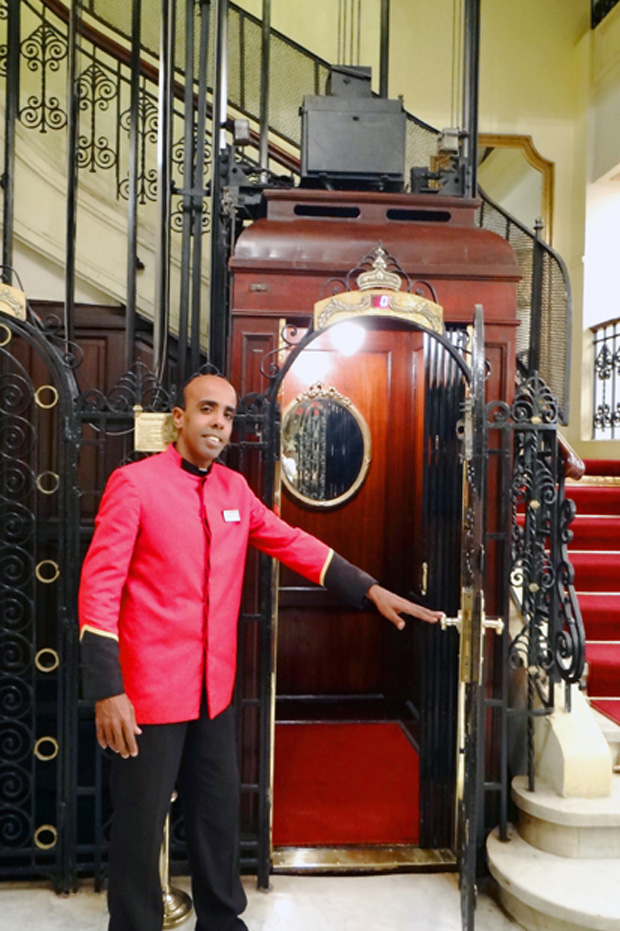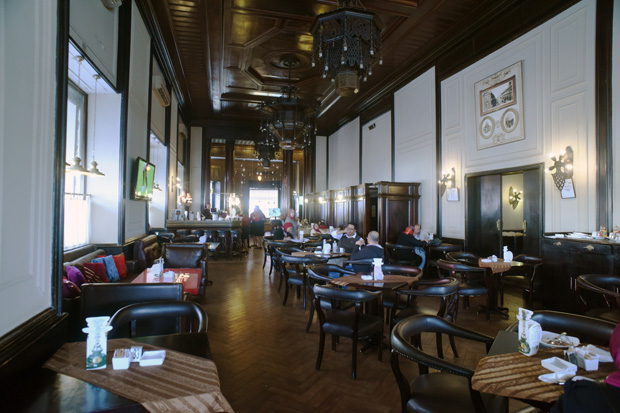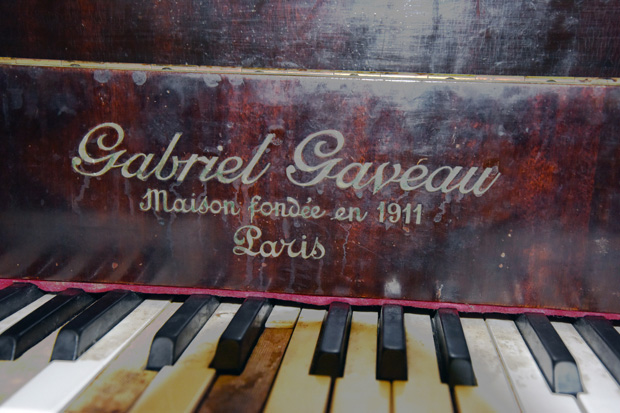Waiting to be rediscovered, Alexandria’s hidden gems are worth the trek through the impossibly crowded coastal city.
by Farah El-Akkad
Egypt’s “Bride of the Mediterranean,” “Maria” or “Lady Alexandria” holds memories for many Egyptians and foreign residents alike: walking in the rain, eating ice cream and drinking mint tea at one of the many Corniche cafes. Despite the political turmoil of recent years, Alexandrians’ continuous complaints regarding sewage-flooded streets and garbage piles, the city still keeps its charm. And today I was planning to rediscover its forgotten gems.
[caption id="attachment_502608" align="alignnone" width="620"] Alexandria's corniche holds memories of vacations past for many Egyptians.[/caption]
Alexandria's corniche holds memories of vacations past for many Egyptians.[/caption]
Driving up into the Raml district, only a couple of streets from Misr Railway station, I craned my neck to take in the view of one of Alexandria’s great architectural beauties. The Steigenberger (formerly Cecil) Hotel, one of the most notable landmarks located on Saad Zaghloul Square, was built in 1929 by the French- Egyptian Jewish Metzger family. Alexandria — The Pearl by Salama Khalifa recounts that one of the hotel’s suites was actually kept by the British Secret Service for their operations in 1930s. Many famous figures were frequent guests such as actor Mahmoud El Meligy (the suite he stayed in is named after him today), writers Naguib Mahfouz (the hotel is portrayed in his novel Miramar) and British playwright W. Somerset Maugham. Other prominent guests included Winston Churchill and Al Capone. The four-star Steigenberger hotel’s interior retains the old-style décor, with high decorated ceilings, spacious rooms and rich, elegant furniture. The view of the unmistakable Saad Zaghloul statue is on the right side of the hotel. One of Cleopatra’s Needles originally existed on this square, and was later gifted in 1877 by Muhammad Ali Pasha to the U.S.
[caption id="attachment_502612" align="alignnone" width="620"] The antique elevator inside the Steigenberger (formerly Cecil) Hotel.[/caption]
The antique elevator inside the Steigenberger (formerly Cecil) Hotel.[/caption]
Across the street is another inviting landmark: the Patisserie Delices. Founded in 1922 by Greek businessman Kleovoulos Moustacas, it is famed for creating King Farouk and Queen Farida’s golden royal wedding cake, each of its seven levels made with real gold. Today, the place still carries a wealth of the old glory with its antique English chairs and picturesque ambiance.
[caption id="attachment_502613" align="alignnone" width="620"] Patisserie Delices[/caption]
Patisserie Delices[/caption]
Just a few blocks away from Delices stands the delightful Trianon cafe, a mainstay in the 1960s when writers Naguib Mahfouz, Beiram El Tonsy and Tawfik El Hakim were regular guests.
[caption id="attachment_502614" align="alignnone" width="620"] Trianon Cafe[/caption]
Trianon Cafe[/caption]
The cafe dates back to 1905, and originally belonged to Greek businessman Yorgos Berelis, who later partnered with another Greek family, the Dreikosen. The cafe was sold to the Egyptian families Luca and Khodairy in 1970s — back then waiters still spoke fluent French and Greek. The place offers a sophisticated and classic English-style interior with a 1911 grand French piano placed in one of the halls. On weekends visitors are treated to a live mix of piano and oud melodies.
[caption id="attachment_502615" align="alignnone" width="620"] The antique piano inside the Trianon Cafe.[/caption]
The antique piano inside the Trianon Cafe.[/caption]
Similar to the Cecil, the Windsor Palace Hotel is another palatial hotel, known for its superb location on the Corniche. Founded in 1906, it is just a short walk away from many of the city’s main landmarks such as the Alexandria National Museum. Both hotels range in price from LE 950-1,300 per night.
The Eliyahu Hanavi Synagogue is one of the oldest sights in Alexandria, located on Nabi Daniel street. Built in 1354, it is considered the largest synagogue in the Middle East and, according to the Lonely Planet, “The magnificent Italian built structure served Alexandria’s once-thriving and cosmopolitan Jewish community. The interior features immense marble columns and space for more than 700 people with brass nameplates still affixed to the regular seats of male worshippers. The community has dwindled and rarely musters the 10 men necessary to hold a service.”
Sadly, most of Alexandria’s museums have been closed since the January 2011 uprising. Few, like the Alexandria National Museum located in Horreya Street in El Raml district, are still open to the public. An LE 3 ticket (LE 10 for non-Egyptians) gets you inside the Italian style palace, which was once home to the U.S. Consulate, to see some 1,800 artifacts collected from other Alexandrian museums. I browsed the well-labeled collection which comprises Ancient Egyptian, Coptic, and Muslim finds, and includes works from the Hellenistic period. On display are canopic jars, mashrabiya, and items dating to the rule of Nectanebo II, and the museum also has a collection of jewelry, weapons, statuary and glassware.
Next I made my way to the Roman Amphitheatre located on Ismail Mehanna Street in Al Attarin (around 15 minutes from El Raml Atation). The site of the extensive Roman theatrical and residential complex was discovered when foundations were being made for an apartment building on the site known as ‘Kom el Dikka’ (mound of rubble). It includes the only known Roman amphitheater in Egypt, an impressively well-preserved structure composed of thirteen terraces. It was constructed in traditional Greek style, with a flat stage in the center on the lowest level. The bench-style seats are all carved out of white or gray marble except for the first row, which is made out of red granite. Excavations in recent years have uncovered Roman baths, lecture halls, and a small village. I walked over to the center of the village to look at the ‘Villa of the Birds,’ a large house filled with beautiful mosaics.
I continued on until I reached Gleem at the other end of the city. The district is named after a Greek member of the Municipal Council of Alexandria. I had by now learned from Alexandria — The Pearl the origins of Alexandrian neighborhood names. Author Khalifa explains that Gianaclis is the name after a famous Greek vineyard owner who resided in the area. Fleming, Stanley and Blockley were the names of British businessmen and members of the Tramway Board of Directors. Zizinia, the neighborhood portrayed in the famous TV series of the same name and the center of resistance during the British Occupation, was the name of a famous Italian cotton merchant. Loran was a French cigarette company owner who was a resident of Alexandria in the 19th century while Semouha is named after Iraqi Jewish fabric merchant Youssef Semouha who came to Alexandria in the late 1800s.
So here I had come to Gleem, leaving the best for last — the famous Royal Jewelry Museum which boasts more than 11,000 pieces of jewelry belonging to the Egyptian royal family including a rich collection of diamond watches, gold medals, diamond gloves and a collection of ancient coins. I was disappointed to find the museum shut, having been closed since 2011. My sole consolation was the splendid views I got to see of the museum’s facade. The building was originally a palace erected in 1919 and belonged to Fatma Al Zahraa, a descendent of the royal family. The palace windows are decorated with lead-inlaid glass artwork of European-style historical scenes and the museum itself is surrounded by landscaped gardens.
Comments
Leave a Comment